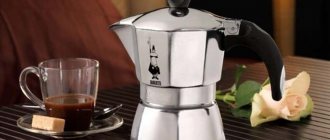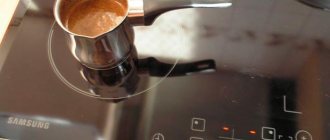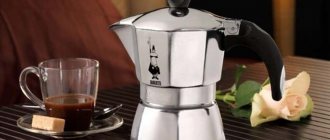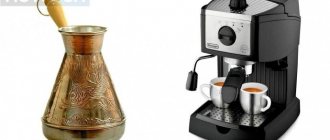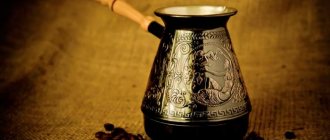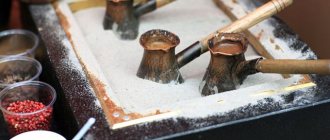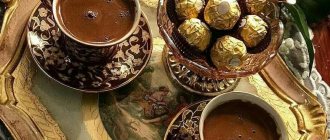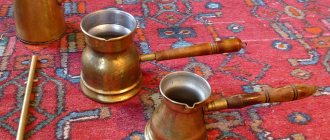Simultaneously with the advent of coffee as a drink, utensils for its preparation also appeared. Coffee lovers prefer to brew this wonderful drink in a Turk (in Arabic - cezva). They were made of metal, ceramics, silver and some other alloys. But the copper Turk always came first. Coffee was prepared in such a container back in the days of the Ottoman Empire. This is where the name of the special dishes came from. Such finds indicate that some of the first Turks used gold and silver to make them, and decorated them with a variety of ornaments and patterns. Nowadays, greater preference is given to tin, copper, steel or ceramics. Why is the copper Turk considered a classic? Because it promotes excellent heat distribution and retention. Ceramic cookware can quickly heat water and enrich coffee with oxygen, but this material is incredibly fragile, which is its main disadvantage. Therefore, you should be very careful when choosing Turks.
Features of a copper Turk
Coffee is prepared in different containers and in several ways. But if you are interested in the end result - an aromatic and tasty drink, then you should buy a copper coffee pot. This vessel cannot be compared with coffee machines, even expensive ones. The diversity of Turks in the modern world is amazing. They can even be purchased at the supermarket. But before you make your final choice, it’s worth learning about the positive and negative aspects of copper cookware. The advantages include:
- heat transfer rate due to fast and uniform heating of the walls;
- sufficient strength, which makes it possible to use in different temperature conditions;
- not subject to mechanical damage;
- operational period (can be used for centuries);
- has an optimal shape, which allows you to preserve the aroma of the coffee drink.
There are also disadvantages that are worth paying attention to:
- copper absorbs the aroma of coffee, so if the variety has been changed, the aroma of the previous recipe may remain for some time;
- high cost of dishes;
- To maintain cleanliness, special care is required using certain compounds to avoid oxidation and scratches. Do not use conventional cleaning products, acid, mesh or metal brushes.
If you analyze the advantages and disadvantages of Turks made from other materials, you come to the conclusion that to make real coffee, a Turk must be copper.
Some facts about copper Turks
It is believed that nomadic tribes from Africa first discovered the coffee drink. They cooked in large copper cauldrons. But it was difficult to roam with such “belongings”, so over time the volume of the pots began to decrease. This is how the dalla came into being - a metal jug with a handle and an elongated spout. This vessel, along with coffee, appeared on the Arabian Peninsula, where the Turks liked it.
Then the Turks modified the dalla, through which a new vessel called a cezve arose. What has changed? The neck was narrowed so that coffee could not spill onto the coals. The handle of the dalla was lengthened to make it more comfortable to hold. Therefore, thanks to such utensils, we prepare aromatic coffee in a cezve. In Russia, this vessel is better known as a Turk.
Copper Turk and modernity
Currently, there is a very large selection of copper Turks and they all have certain differences.
- Copper utensils made of fine copper. Such specimens are often presented as souvenirs. They have insignificant weight, unclear decorative patterns, and unfinished trim edges. Is it possible to brew coffee in a copper pot like this? You can, but you won't enjoy the drink.
- Copper Turks made of thick copper. Such dishes are not decorated, but this does not detract from the advantages of preparing an appetizing drink. Such dishes are not sold in supermarkets or online stores. As a rule, preparation is carried out in Greece and Turkey in small private industries. Why should you brew coffee in a copper pot like this? Because the parameters of the bottom of the cezve are of considerable importance for uniform heating.
- Stamped copper Turk. For production, thin metal is used, which undergoes special processing. The bottom of such dishes is thickened. These cezves look like barrels with a large bottom and a narrow neck.
- Copper Turk with applied embossing. This option can be purchased at a specialized retail outlet or in a handicraft shop. It has one feature - the embossing plates make the product unique. Such a vessel is weighty; considerable thickness of the walls is achieved thanks to embossing. This modern copper pot allows you to enjoy excellent coffee and will perfectly decorate your kitchen.
Important! Modern Turks are equipped with an internal coating, which protects the copper surface from oxidation. The protective layer is a layer of stainless steel or food grade tin. There is also a silver coating, but it is expensive.
Choosing a cezve depending on the type of hob
Stoves vary from house to house, and sometimes you have to choose a container based on the type of stove you are using. There are not many nuances, but they are there:
- You can buy anything for a gas stove: a classic copper pot, ceramics, glass, and other metals. The only peculiarity is that for clay and porcelain it is recommended to install a flame divider so that the dishes heat up more slowly and the water does not boil.
- For an induction hob, it is advisable to choose a coffee maker from a material that has magnetic properties. Copper, aluminum and ceramics are not suitable. But stainless steel is often the best choice. Or use a special adapter for induction cookers.
- For an electric stove, you can use any type of pot, the main thing is to remember to remove the container from the heated surface so that the cooking process does not continue.
- For preparing a drink over an open fire, outdoors or by the fireplace, an aluminum cezve is well suited, as it is easy to clean and very light. Models with complex designs should not be used, as they are difficult to clean later.
If you have a different, special hob, check with the instructions or with the sellers what to use.
Comparison of copper Turk with other materials
The copper pot is very popular among coffee lovers due to its original characteristics and affordable cost. It brews coffee quickly and cools slowly, has ideal shapes and a comfortable handle, is durable and reliable, looks beautiful and is easy to clean. But there are other materials for making such utensils: stainless steel, ceramics, glass, clay, aluminum, silver, bronze, brass.
Which cezve is better: ceramic or copper?
. Both are used for preparing many types of coffee, since they do not absorb essential oils and foreign odors. You can brew a new drink in them every day, the taste of which will not be affected. But ceramics belongs to the category of a more environmentally friendly product. Does not interact with the environment and does not create harmful compounds. But ceramic containers are more fragile and cost more than their copper counterparts. But if you are careful and not strapped for money, then a ceramic Turk will come in handy. If dishes fall out of your hands with enviable regularity, then opt for a copper pot. It brews coffee perfectly, just do not clean the surface with abrasive substances.
Which Turk is better: copper or stainless steel?
In the modern world, everything is constantly changing, and so are the containers for making coffee. Along with the classic copper one, stores also offer a stainless steel model. And everyone tries to ask themselves the question: what kind of cezve should I buy? The pros and cons of copper containers have been mentioned above. Now let's look at the advantages of stainless steel Turks:
- the cost is two times less than copper ones;
- easy to maintain, although regular maintenance is required to maintain the polished surface;
- durable, do not break, do not break, do not melt, do not oxidize.
But there are also disadvantages that need to be taken into account:
- low thermal conductivity, so they heat up slowly, the heat is distributed unevenly, and the aromatic bouquet of coffee is poorly felt;
- unattractive, reminiscent of small scoops with a huge neck, which promotes the formation of foam and evaporation of the aroma of coffee;
- coffee prepared in such a container has a metallic taste, which will ruin the impression of even an expensive drink;
- cools down slowly, so even if you leave the coffee off the stove in time, it will still run off.
On a note! Recently, stainless steel Turks with a traditional shape began to appear. But since this material retains heat for a long time, the narrow neck causes the coffee drink removed from the tile to boil over.
Turks for gas stove
Both copper and ceramic pots are suitable for a gas stove; only when brewing coffee in the latter, it is better to use a flame diffuser so that the coffee does not boil ahead of time and the pot heats up more slowly.
Options for induction cooker
An induction cooker conducts heat through the cookware, so when choosing a coffee pot, it is important to remember that ceramic and copper pots are not suitable for an induction cooker (they do not conduct heat well), it is better to use enameled steel pots.
Not all materials are suitable for an induction cooker. There are specially designed models made of ceramic or copper, at the bottom of which there is an insert made of ferromagnetic material, which allows the induction cooker to “recognize” the bottom of the Turk. Usually the manufacturer notifies the buyer about this by leaving the word Induction on the packaging. The disadvantages of such a Turk are that it does not have a classic shape and its neck is too wide.
How to choose the right copper Turk
When choosing this kitchen item, you should pay attention to the following points: shape, material, volume, product quality and other features. After all, you buy a cezve for a long time. The container must meet all requirements.
Turks uniform
The correct shape of the cezve is cone-shaped, with the neck 2-3 times narrower than the bottom. This results in rapid and even heating of the coffee drink and minimizes the evaporation of essential oils. Thanks to the narrow neck and the resulting foam, the taste and aroma of coffee is preserved.
Turks size
It shouldn't be bulky. The optimal option is one that holds 100g of water. Connoisseurs believe that the smaller the vessel, the more aromatic the coffee prepared in the container will be. But you should immediately calculate how many people will drink this drink at the same time and, based on this, decide on the volume of the cezve.
Turk wall thickness
Metal vessels with walls of 1.5 mm are considered ideal. In such containers, the coffee heats up evenly and not quickly. You can purchase a container with a thick bottom. You can use them to make coffee on sand. If the cezves are thin-walled, then you should not purchase them. This indicates low quality. It is worth paying special attention to the internal coating. The surface should not be damaged and lie in an even layer.
Turkish pen
If you are going to brew coffee on a stove or sand, then you should choose a pot with a long handle attached at an angle. This will relieve possible burns to the skin of your hands. The handle should not heat up, so choose a wooden or metal one with minimal thermal conductivity. When heated, plastic emits an unpleasant odor, which will negatively affect the finished product. Pay attention to the way the handle is attached. It should not dangle or fall off in the first days of its use. If the handle is removable, then it is convenient to store such a copy in a cabinet.
The handle of the Turk should be durable and comfortable
Form
There are 3 forms of Turks:
- Conical. The bottom is twice as wide as the neck, so the drink warms up evenly and retains the aroma better. Typical for copper products.
- Barrel-shaped. Requires slow heating and constant monitoring so that the foam does not run away. Smooth, rounded lines are inherent in clay products.
- Cylindrical. Steel, aluminum and glass products are often shaped in a way that is completely unsuitable for making coffee.
Solid copper pot - what is it?
This concept arose after some “economical” manufacturers began to make cezves from two parts. This makes the product cheaper, but makes it of poor quality and sometimes hazardous to health, because improperly sealed seams can burst and boiling water gets onto exposed areas of the body. To disguise welds, manufacturers began to decorate them with all kinds of ornaments. Pay close attention to such items, and you should not go after cheap prices, because such dishes can fall in half at any moment, causing harm not only to your table or stove, but also to your health. A solid copper vessel is made from a single piece to which a holder is attached. This dish has no seams; only the handle fastenings can be seen on it.
How to recognize a compound Turk?
- Pay attention to the cost right away. A welded Turk is cheaper than its solid counterparts.
- Carefully examine the surface of the container: are there weld seams hidden behind the beautiful pattern? You can also examine the product from the inside. It's much more difficult to hide the seam there.
- Composite cezves are usually sold in markets, souvenir shops and artisanal outlets. Therefore, visit a store that inspires trust and carefully study the product offered by the seller.
How to use a ceramic Turk on a gas stove?
- The ceramic pot is safe to use on a gas stove. There is no need to worry that the container will crack or burst. The firing temperature used to harden ceramics is much higher than the temperature that a gas stove can provide.
- Make sure that the ceramic pot stands level and stable on the burner. The diameter of the burner should be less than the diameter of the bottom of the Turk.
- If your stove does not have a burner of a suitable diameter, we advise you to use a metal divider. With its help, you will securely install the Turk and ensure even heating.
- In addition, such a cutter will help preserve the original appearance of the Turk, because high flames can smoke the sides of the cezve.
Coffee should be prepared in a ceramic Turk over the lowest heat. This ensures even heating of the dishes.
How to brew coffee in a copper Turk - step by step
Any coffee connoisseur will tell you that a boiled drink has no value. It will not have a charming aroma and taste. Therefore, coffee is not brewed, but brewed. Below we will tell you how to properly brew coffee in a copper pot on the stove.
- Pour ground coffee into the Turk.
- If you prefer a sweet drink, immediately add sugar to taste.
- Fill the contents with clean cold water.
- Place the Turk on low heat or in the sand and wait for the coffee powder to heat up.
- Stir the drink thoroughly until foam forms.
- After the foam darkens and the first bubbles appear, the cezve is removed from the stove.
On a note. The best Turkish coffee made in sand. The coffee has a thick consistency, dense foam and a wonderful aroma.
Volume and handle
The smallest Turks hold only 100 ml of drink, the largest – up to 700 ml. The most common models are 250-300 ml (two servings).
- More on the topic: Coffee beans - rating of the best brands for Turkish coffee
You should not choose a container “with a reserve”: you need to prepare as much drink as it can hold in order to achieve a harmonious taste and rich aroma. Baristas believe that a small pot is better for brewing coffee.
The long handle is made of a material with good thermal insulation: wood or heat-resistant plastic (Bakelite). The metal handle will get very hot and will require an oven mitt. It is preferable to choose fastening with bolts.
Maintenance and repair
Repair of copper pots is subject to only specialized enterprises that provide the following services:
- the cracks are puddled;
- eliminate deformed areas;
- restore the tin coating;
- handles are inserted or replaced.
These breakdowns occur if there are initial defects in the product or the Turk has been improperly cared for. But before you send your vessel for repair, you should find out about the cost of services. It may happen that repairing the Turk will cost more than the original price. In this situation, it is better to buy a new model.
In order for a Turk to last a long time, it is important to properly care for it.
General recommendations for selection
If, after studying the theory, you still haven’t made your choice and don’t know which Turk is best to buy for brewing coffee on the stove, then use these general tips.
If you have never brewed coffee in a cezve, choose a tall metal one (copper or brass) with a narrow neck. This will increase the likelihood that the foam will not escape. It is also good to learn how to brew coffee in transparent quartz Turks, observing the internal processes.
To get a tasty and rich drink on the stove, buy a ceramic, porcelain or clay Turk. In such dishes you get a “sand effect”. If you plan to cook different varieties, then clay without glaze will not work. It is more correct to have a separate cezve for flavored types. Remember that in ceramics it is more difficult to control the cooking.
To make coffee with milk, it is better to get a glass coffee maker. It is also suitable for various experiments with chocolate, juices and other additives. A quartz cezve is suitable for these tasks, but its price is several times higher.
To choose a high-quality Turk, carefully inspect it outside and inside, make sure the integrity of the body and coating. It is especially critical to inspect handicraft products sold at fairs and market stalls.
Reviews
Experts recommend purchasing Turkish “Eastern Beauty” 500 ml. It is ideal for making excellent coffee and has a high-quality, comfortable wooden handle.
It is worth paying attention to the copper Turk 500 ml from the Stanitsa company. This brand has been on the cookware market for more than a decade. The products of this company are distinguished by their original design, ergonomic shape, high quality, certificates, and affordable price. This pot will make you excellent coffee and decorate your kitchen interior.
SOY Turk made of silver 200 ml is very elegant, beautiful, aesthetic, made of thick hand-forged copper, coated with silver inside, with a bronze handle. The manufacturer is the Istanbul company SOY, which specializes in the production of cezves.
To dust or not to dust, that is the question
Sergei Blinnikov:
“Thanks to the grounds, coffee from the cezve continues to be extracted in the cup until it is completely drunk. This is both good and bad: with the right recipe and grinding, the drink will open up better and better every minute!
But there is a problem: with such a long extraction, up to 20-30 minutes, there is a great danger of overbrewing the coffee and getting extra bitterness in the taste. This needs to be taken into account when choosing the grind.
Choose according to the principle “the darker, the larger.” For example, I brewed Yemen Matari No. 4 (light roast), Brazil Irmas Pereira 36 Hour Fermentation No. 170 (medium roast, dark filter), and Honduras San Marcos No. 22 (darker than medium roast). All beans gave off enough sweetness with a coffee to water ratio of 1:8-1:9 (12 g of coffee per 100 ml of water). But Yemen opened up with an espresso grind, and for Honduras we had to take a grind that would be suitable for a Chemex. Unfortunately, with such a coarse grind, the coffee loses its body, but we remove excess bitterness from the drink. Although when brewing group B it is not possible to completely avoid bitterness - this is a dark roast.
If you don’t like grounds in your cup, filter the cezve using paper filters. The V60 funnel or AeroPress will give you a clean drink. But the thicker the layer of paper, the lighter the cup you will get.”
Turk wall thickness
Optimally - one and a half millimeters when it comes to copper. A too thick bottom and thin walls indicate that the cezve is not solid, but welded together from separate sheets. On the one hand, there is nothing wrong with this, and thick-bottomed vessels are ideal for heating on the sand. But such a Turk should cost a lot of money, because silver must be used for such soldering according to food technology. It seems that instead of silver, most manufacturers use less “pedigreed” substances of dubious origin.
